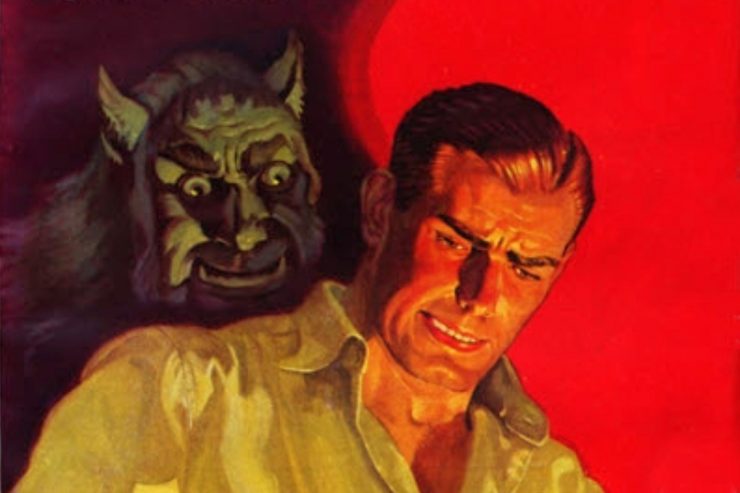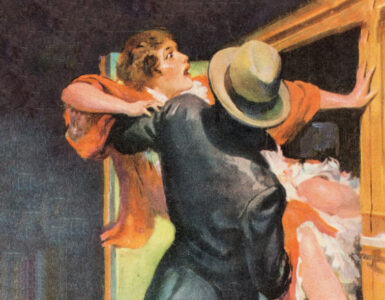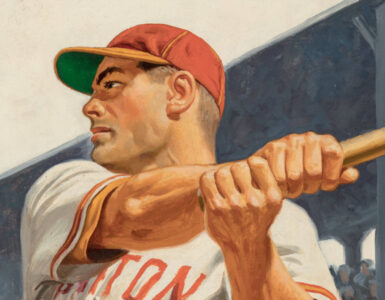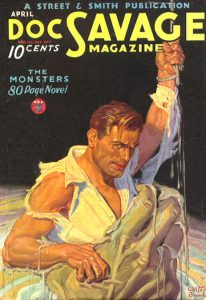 Although Street & Smith regularly published Christmas and New Year’s issues in Detective Story Magazine and their other weekly titles, they didn’t seem to lean too strongly into the concept of seasonal- or holiday-theming their other titles, particularly the hero pulps.
Although Street & Smith regularly published Christmas and New Year’s issues in Detective Story Magazine and their other weekly titles, they didn’t seem to lean too strongly into the concept of seasonal- or holiday-theming their other titles, particularly the hero pulps.
You won’t find any Whisperer St. Patrick’s Day adventures or Avenger Thanksgiving thrillers.
That said, you can make the argument nearly every Street & Smith hero pulp worth its salt celebrated or at least “suggested” Halloween.
Lester Dent and his fellow “Kenneth Robesons” festooned Doc Savage’s bibliography with its share of titled “hexes,” “monsters,” “werewolves,” “goblins,” “ogres,” “spooks,” “running skeletons,” “black, black witches” and “devils.”
But when it came to the supernatural, Doc Savage Magazine tended to be more tease than trafficker in true supernatural terror.
It’s become a kind of commonplace assertion — clichés become clichés because of their foundation in fact, after all — that the Doc Savage tales were kind of forerunners of television’s Scooby-Doo cartoons.
You know — the ones in which the “meddling kids” reveal some seeming monster is simply the gone-wrong, get-rich-quick scheme of a bent realtor, banker, or a sketchy small-town politician.
Still, Doc occasionally flirted with truly bending “reality,” memorably battling gangsters turned over-sized “Monsters” in the 1934 story of the same name, and encountering another oversized creature seemingly earning its nickname in 1939’s “The World’s Fair Goblin.” Doc, himself, once even resurrected the dead.
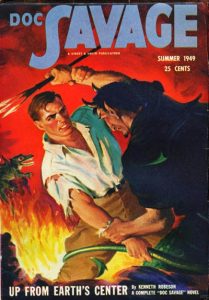 Most famously, in his last published pulp tale, 1949’s “Up From Earth’s Center,” Doc and his aide, Monk, apparently journey underground into the caverns of Hell. There they encounter impossible-to-comprehend beings that drive the formerly stoic Doc into screams of terror and send the pair of adventurers fleeing back to the surface with the novel’s central mystery left uniquely unresolved.
Most famously, in his last published pulp tale, 1949’s “Up From Earth’s Center,” Doc and his aide, Monk, apparently journey underground into the caverns of Hell. There they encounter impossible-to-comprehend beings that drive the formerly stoic Doc into screams of terror and send the pair of adventurers fleeing back to the surface with the novel’s central mystery left uniquely unresolved.
Walter B. Gibson, on the other hand, played both sides of the supernatural fence in his Shadow stories written as “Maxwell Grant.”
The magic-infatuated Gibson wrote his lion’s share of novels toying with seeming supernatural menace, ultimately revealed to be trickery in the third act of his staggering oeuvre of Shadow novels.
On the other hand, Gibson could also press the envelope in the opposing direction, seemingly pitting The Shadow against truly occult opponents ranging from mind-manufactured “tulpas” and the actual risen-dead in various Shiwan Khan-centered Shadow novels. Or the “zombies” conjured by one of his other great recurring foes, Rodil Mocquino, AKA, “The Voodoo Master.”
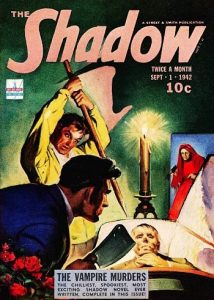 As Halloween 2021 and the Season of the Witch looms, may we suggest you consider taking a trip to Salem, Massachusetts, with big-fisted Doc Savage chum Renny Renwick, in 1939’s “Hex,” or perhaps dare to delve into arguably the strangest of all Shadow novels, “The Devil Monsters,” originally published in 1943?
As Halloween 2021 and the Season of the Witch looms, may we suggest you consider taking a trip to Salem, Massachusetts, with big-fisted Doc Savage chum Renny Renwick, in 1939’s “Hex,” or perhaps dare to delve into arguably the strangest of all Shadow novels, “The Devil Monsters,” originally published in 1943?
Be sure to bookmark pulpfest.com so you can see all of our latest updates. You can also keep up to date via the PulpFest Facebook page, our Twitter account, or our posts on the PulpFest Instagram page.
Happy Halloween to one and all. Be safe and stay well! We look forward to seeing you at PulpFest 50!
We’d also like to introduce Craig McDonald, our newest PulpFest writer.
The author of the Edgar-nominated HECTOR LASSITER historical crime series, Craig is an award-winning novelist, journalist, and editor. His series chronicles the exploits of a fictional BLACK MASK author and his encounters with such notable figures as Ernest Hemingway, Orson Welles, Ian Fleming, and Lester Dent. In addition to his Edgar nomination, Craig was also a finalist for the Anthony, Gumshoe, and CRIMESPREE MAGAZINE awards for best first novel.
As Craig mentioned in his post, Doc Savage and his Fabulous Five faced “The Monsters” in the April 1934 issue of DOC SAVAGE MAGAZINE, featuring cover art by Walter M. Baumhofer. The artist also painted the cover art for “Brand of the Werewolf,” running in the January 1934 number of the magazine.
Fifteen years later Doc Savage may have come face-to-face with Old Scratch himself in “Up From Earth’s Center.” The story originally ran in the Summer 1949 issue of DOC SAVAGE, the pulp’s final number. It featured cover art by George J. Rozen. The artist also contributed the cover painting for the September 1, 1942 issue of THE SHADOW, featuring Walter B. Gibson’s novel, “The Vampire Murders.”
Be sure to visit us next Monday, November 1, for “Birth of the Dime Dynasty,” another “Pulp History” lesson brought to you by PulpFest 50.

